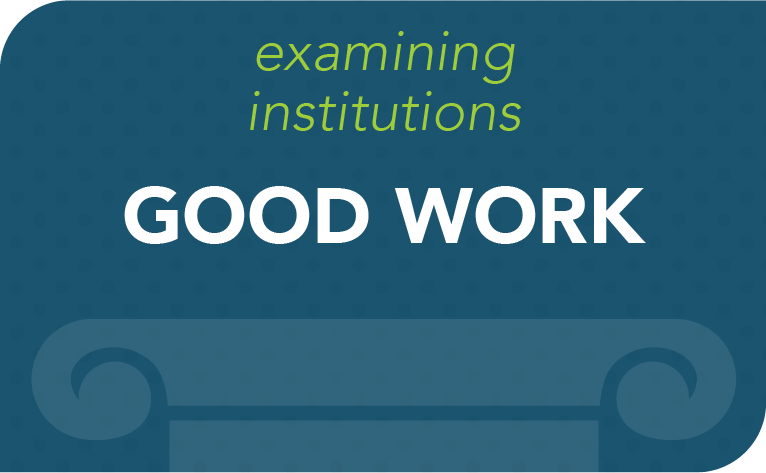
Engaging Students in the Good Life of Learning
August 2022
Katherine Jo, Ph.D.
Director of Program Development and Design, The Purpose Project
The Kenan Institute for Ethics
Duke University
I have upwards of sixteen years of formal education, and only once in any classroom was I encouraged to talk honestly and openly about the sense of mystery and depth that I frequently experience in my own life. […] Why can’t we ever talk in higher education about what gives lives real meaning?
—Student1
How can college educators engage students more effectively in the classroom? Two years of learning and living through the COVID-19 pandemic seems to have precipitated a “student-disengagement crisis,” despite the return to in-person classes at most colleges.2 Students’ disengagement from academics, however, has always been a challenge.3
Discussions about how to engage students usually focus on teaching methods, such as “active learning strategies.”4 But what exactly are we engaging students in and for?
The language of engagement obscures the deeper purposes of teaching undergraduates. I am not referring here to developing students’ critical thinking skills, broadening their perspectives, building their civic capacities, or even cultivating virtues. These are all good and right aims that constitute the intrinsic value of college, but students will only grow in these ways if they earnestly engage in learning. To motivate earnest engagement, our teaching must be guided by the larger goal of students’ flourishing and a more student-centered understanding of what this means.
Today’s “emerging adult” undergraduates are trying to figure out who they are and want to become, and how to make sense of life, in a world of enormous uncertainty and complexity.5 When their learning connects to these existential yearnings, students engage. This fact is borne out by the immense popularity of “happiness” courses at various institutions. Students want what they are doing in their lives—including learning—to matter beyond surviving the next test and to contribute something good to the world. We must aim in our teaching—our subject matter, assignments, grading practices, classroom environment, and various interactions with students—to show students that their learning matters for living good, meaningful, and purposeful lives, not just later, but in their present lives. Connecting our teaching to students’ desire for meaning and purpose, however, is not ultimately about getting students to engage in the learning process. It’s about engaging them in the good life, and, in turn, making learning part of the good life they seek.
Faculty of all disciplines, not just those who teach happiness courses, can nurture students’ sense of meaning and purpose by integrating the following practices and virtues into their teaching:
Framing one’s discipline in terms of the “big questions”: When students understand how our disciplines and course subject matter are motivated by fundamental human questions (e.g., what can we know? How should we live, individually and collectively? What does it mean to be human, and how should we relate to the world around us?), they see why what they’re learning matters—for themselves and for humanity.
To help students see their organic chemistry course as more than a requirement to fulfill, two organic chemistry instructors asked students to consider these kinds of questions in one of their weekly journal assignments: “We encourage you to ask, ‘Why?’ at every step of the way along your future educational and professional careers. Why did Nature choose phosphates? Why does our body need to be at pH 7? Why do we take exams in organic chemistry? Why should anybody care about organic chemistry?”6 Questions like these create openings for students to experience wonder and to practice pursuing meaning.
Connecting course material to personal growth: When students are given an opportunity to engage with course material on a personal level, it makes the intellectual work more than an exercise. For example, Harvey Mudd College Professor of Mathematics, Francis Su, asks his students to offer a written reflection on an interesting idea they learned in the class and “what it tells you about doing or creating mathematics.”7 Having talked to them about the importance of struggling through problems, he also asks them to reflect on a time when “struggling and trying something was valuable to you.”8 These questions can be adapted for any course and modified to help students consider the value of what they’ve learned for their civic and career development.
Hospitality, care, earnestness, and community-mindedness: When students feel a sense of belonging and feel cared for as growing individuals, apart from their academic performance, they develop a commitment to learning as part of the classroom community. Our educational practices—from classroom activities to grading—should aim to build relationships with and among students that are characterized by trust, care, and collective commitment to the educational endeavor. Making the effort to learn students’ names,9 arriving to class 10-15 minutes early to chat with them, sharing some of one’s own experiences, and encouraging students to talk to each other through group activities creates a welcoming environment, shows students they matter as human beings, and, consequently, humanizes the learning experience, socially and intellectually. James Lang offers several examples of how faculty in various disciplines have incorporated some of these practices on the first day of class to set the tone for the semester.10
Most faculty have not been formed as professionals to view themselves as educators who support students’ flourishing and to teach in the ways described above. At the Purpose Project at Duke, we are making student flourishing and questions of meaning and purpose central to the formation of faculty through a program called Teaching on Purpose. The program brings doctoral students and faculty across the disciplines together to explore what it means to be a good teacher of undergraduates with a view toward helping students flourish, as learners and as human beings. We move beyond instructional strategies and work to cultivate practices and virtues that enable meaningful learning.
For most participants, this approach is somewhat foreign, as their past and current experiences in higher education are like that of the student quoted at the top of this article. But they come to value learning that is framed by big questions, connected to their personal growth, and embedded in a hospitable and caring learning community by experiencing it themselves at the weekly Teaching on Purpose sessions. Past participants say the program contributed to and reoriented their own sense of meaning and purpose as educators, learners, and human beings.
When it seems like students are disengaged and only care about the instrumental ends of education, I’m inclined to think it’s because we haven’t made enough space in our classrooms for “what gives lives real meaning.” Our classrooms are more than places where students can gain valuable knowledge and develop capacities for leading good lives in the future. They can and should be places where students engage in and experience the good life itself through their learning.
[1] Robert J. Nash and Michele C. Murray, Helping College Students Find Purpose: The Campus Guide to Meaning-Making (San Francisco: Jossey-Bass, 2010), 39.
[2] “How to Solve the Student-Disengagement Crisis,” The Chronicle of Higher Education, May 11, 2022, https://www.chronicle.com/article/how-to-solve-the-student-disengagement-crisis.
[3] Wendy Fischman and Howard Gardner, “Students Are Missing the Point of College,” The Chronicle of Higher Education, May 25, 2022, https://www.chronicle.com/article/students-are-missing-the-point-of-college; Beth McMurtrie, “A ‘Stunning’ Level of Student Disconnection,” The Chronicle of Higher Education, April 5, 2022, https://www.chronicle.com/article/a-stunning-level-of-student-disconnection; Robert Zaretsky, “Yes, Students are Disengaged. What Else Is New?,” The Chronicle of Higher Education, May 20, 2022 https://www.chronicle.com/article/yes-students-are-disengaged-what-else-is-new.
[4] Cathy N. Davidson and Christina Katopodis, “10 Arguments for Inciting Learning,” Inside Higher Ed, July 20, 2022, https://www.insidehighered.com/advice/2022/07/20/why-active-learning-more-effective-traditional-modes-opinion.
[5] Jeffrey Jensen Arnett, Emerging Adulthood: The Winding Road from the Late Teens Through the Twenties (New York: Oxford University Press, 2015).
[6] Gabe Rudebush and Jose Zavalas, “Journal 8,” 2018.
[7] Francis Su, Mathematics for Human Flourishing (New Haven: Yale University Press, 2020), 123.
[8] Ibid., 124.
[9] Richard A. Detweiler reports that knowing students’ first names is associated with certain positive adult life outcomes. The Evidence Liberal Arts Needs: Lives of Consequence, Inquiry, and Accomplishment (Cambridge: MIT Press, 2021), 19.
[10] James M. Lang, “How to Teach a Good First Day of Class,” The Chronicle of Higher Education, August 21, 2018, https://www.chronicle.com/article/how-to-teach-a-good-first-day-of-class/.





